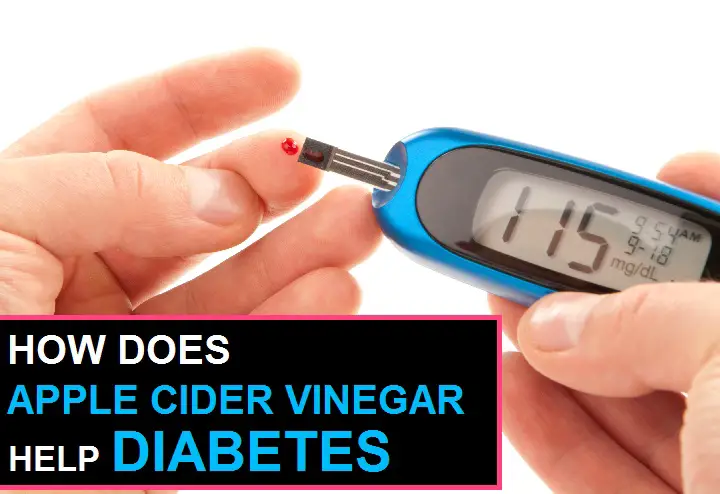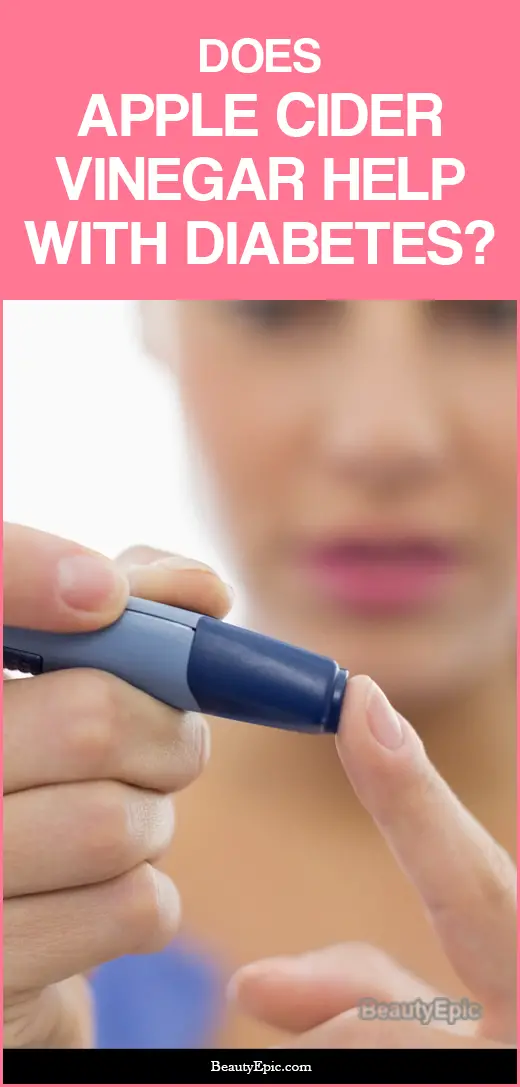
Important: This article is for informational purposes only. Please read our full disclaimer for more details.
Diabetes is characterized by high blood sugar (glucose) levels that result from defects in insulin secretion, or its action and in some cases both. High levels of sugar in the blood, leads to an increase in the risk of heart stroke, nerve damage and kidney disorder. Natural remedy incolving the use of Apple Cider Vinegar have been proven to be extremely beneficial to curb the levels of sugar in the body.(1)
Does Apple Cider Vinegar Help In Relieving Diabetes?

Apple cider vinegar is regarded as a healthy and natural medication for various diseases and diabetes is one of them. Given below are some of the reasons why we can rely on apple cider vinegar(2)
- Apple cider vinegar is a good source of polyphenols which help in prevention of diabetes.
- Absorption of carbohydrate or breaking down of starches intosugar can be slowed down by ACV.
- It helps to block down some of the starch we eat from being digested.
- The antiglycemic properties of apple cider vinegar, helps patients with marked resistance to insulin.
How To Use Apple Cider Vinegar for Diabetes?
There are various drugs that are used to fight diabetes. This is a proven supplement for various diabetes related drugs and is known to keep diabetes at bay. Some of the methods of used for consumption of apple cider vinegar are given below.
[ Read: How to Take Turmeric for Diabetes ]
Directions For Use Of Apple Cider Vinegar
Apple Cider Vinegar for Diabetes
This is a very easy method that gets you quick relief.(3)
- Just add one tablespoon of apple cider vinegar in one lass of water and drink it after each meal.
Apple Cider Vinegar With Lemon Juice for Diabetes

The lemon not only helps to rejuvenate you but also ensures that you do not fall ill frequently.(4)
- Add the juice of 3 lemons in a bowl and one fourth cuo of ACV.
- Mix it thoroughly and drink it once a day.
[ Read: Benefits of Okra for Diabetes ]
Apple Cider Vinegar and Baking Soda for Diabetes
If you are opting for this methd, you need to be really careful with the dosage so taht you do not cause any unwarranted harm to yourself.(5)
- Take a glass of water and add one fourth tablespoon of baking soda and 1 teaspoon of ACV.
- Ensure to drink this on a regular basis.
Apple Cider Vinegar and Flax Seeds for Diabetes
You can use flax seeds if you have them in the house. They also help to reduce your blood sugar.(6)
- Add 2 tablespoons of flaxseeds to 2 cups of boiling distilled water.
- Boil for 10 minutes after that strain the seeds.
- Add a tablespoon of apple cider vinegar to strained water.
- Drink this regularly.
[ Read: How to Take Cinnamon for Diabetes ]
Tips And Precautions
Apple cider vinegar is a very natural method of treating diabetes. However, certain precautions must be maintained while consuming it.
- Apple Cider Vinegar may cause more frequent urination. Hence while travelling the usage should be reduced to avoid discomfort.
- Drinking Apple Cider Vinegar may make you queasy or gassy. One should dilute it or consume it with food to prevent these side effects.
Regularly drinking Apple Cider Vinegar may lead to low potassium. Consider taking multivitamins daily and eating potassium-rich foods.
You Might Also Like:
- 6 Amazing Beauty Benefits of Apple Cider Vinegar
- Top 10 Home Remedies That Can Help You Control Diabetes
- Yoga for Diabetes – 10 Best Yoga Asanas for Diabetes
- How Good is Okra for Diabetes?
- Apple Cider Vinegar for Razor Bumps – Benefits, Uses and Prevention Tips
- Does Cinnamon Help Diabetes? Benefits and Precautions
- How Good is Okra for Diabetes?
- OZiva Superfood Greens & Herbs for Diabetes and Prediabetes
- How To Use Turmeric For Diabetes?
- Is Honey Good for Diabetics Patient?
- Does Apple Cider Vinegar Help with Diabetes?
- Yoga for Diabetes – 10 Best Yoga Asanas for Diabetes
- 7 Best Lotions For Diabetic Dry Skin
Image:- 1
















